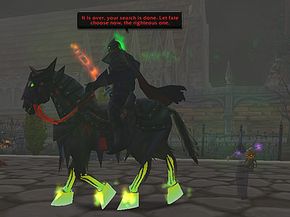How is group play different from solo play?
When you're playing "World of Warcraft" on your own, you basically try to kill mobs before they kill you. You also claim 100 percent of the mob's loot and experience. But group play is a little different. You share loot and experience with the other party members, and, ironically enough, trying to kill an enemy as fast as possible can lead to disaster. Instead, you have to use your skills and abilities to the benefit of the whole party.
Your classes and talents, discussed in the "Warcraft Characters" section, have a huge impact on your role in a group:
Advertisement
- Tanks have lots of armor and health and can survive a lot of damage. They also have tools for generating threat -- the more threatening a mob finds a character, the more likely it will be to attack that character. So the tank's job is to get (and keep) a mob's attention and absorb lots of damage in order to protect the rest of the party.
- Healers keep the tank and the rest of the party alive during the fight. Healers have to use their mana to heal the party, and healing can generate a significant amount of threat. For this reason, good healers save their most powerful spells for absolute emergencies so they can conserve their mana and reduce their threat.
- The rest of the party is the DPS, which stands for damage per second. As with healers, DPS characters can generate lots of threat as they're fighting mobs, so they have to learn to balance their damage output with their threat production.
In raids, or instances that require more than five players, there are often multiple tanks, also known as off-tanks, and multiple healers. Often, raid leaders or class leaders will give these players specific tanking or healing assignments.
Many classes also have the ability to temporarily incapacitate, or crowd control (CC), mobs. In difficult encounters, CC can be extremely important -- it keeps the group from having to defend themselves against too many monsters at one time. The party must make sure not to attack these mobs -- most forms of CC break when the mob takes damage.
There are lots of forms of crowd control in the game. Here are some examples of the ones commonly used in instances:
- Sap: A rogue sneaks behind a target and incapacitates it. This works only on humanoids that aren't in combat.
- Sheep: A mage casts a polymorph spell to turn a target into a sheep. Mages can also turn enemies into turtles and pigs, but this is still generally referred to as sheeping. Sheeping works only on humanoids, beasts and critters.
- Shackle: A priest encases an undead enemy in chains.
- Banish: A warlock makes a demon or elemental completely immobile and invulnerable. Players can't harm it, but it also can't harm players. Warlocks can also enslave demons and force them to attack mobs rather than the party.
- Trap: A hunter places a trap on the ground that freezes the mob in place.
- Hibernate: A druid causes a beast or dragonkin to fall asleep.
- Root: A druid entangles a mob in living roots. This only works in outdoor instances, like Zul'Gurub and Zul'Aman.
- Fear: Priests, warlocks, warriors and paladins can cause various mobs to run away for a certain amount of time. This isn't often a good idea in an instance -- the feared mob can run into other mobs and bring them back to your group.
This may sound complex, but there are lots of tools for making it easier to keep up with who's responsible for which mob or character in the instance. In the next section, we'll look at some of them.
